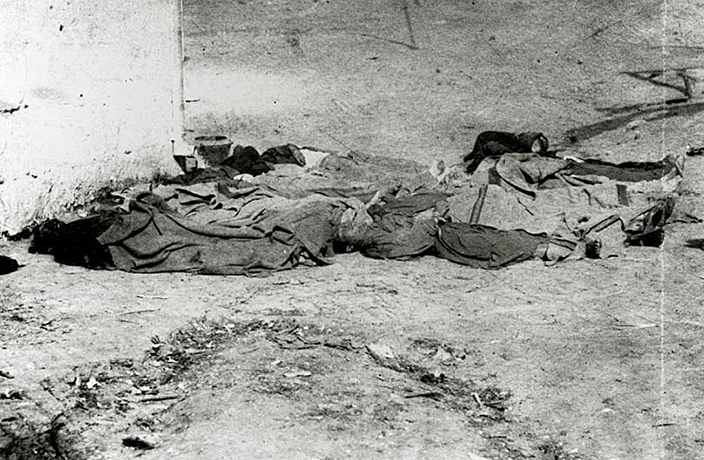The voice at the other end of the line was terse and to the point: “The Japanese have bombed Pearl Harbor in Hawaii, and Britain is consequently at war with Japan.” Lieutenant Stephen Polkinghorn was not surprised at the news from the British Embassy in Shanghai – nor at what came next.
“Obviously, there is nothing you can do with the forces at your disposal. I would suggest that you strike your colors,” the diplomat continued in measured tones. “You can expect a visit from the Japanese at any time.”
It was before dawn on December 8, 1941 – what President Roosevelt called the “day of infamy” (because of the International Date Line, Shanghai was a day ahead of Pearl Harbor) – and Polkinghorn had just been advised to surrender HMS Peterel to the Japanese.
It was the Royal Navy’s only remaining Yangtze River gunboat in China and represented the last regular British armed force in Shanghai. But as Polkinghorn replaced the receiver in its cradle, his lip curling in disgust, one thing was clear to him: there would be no simple surrender.

HMS Peterel, the last British gunboat in China that was sunk in a blaze of glory on the Huangpu River on December 8, 1941 – the only resistance to the Japanese takeover of the International Settlement
HMS Peterel sat moored on the Huangpu, opposite the Bund, Shanghai’s glittering, neoclassical million-dollar mile. A Japanese gunboat moved in the distance, a signal lamp sending coded Morse to the riverbank, and a curl of smoke rose from the funnel of the huge Japanese cruiser Izumo moored close by.
The Peterel had been protecting British trade on China’s rivers since 1927, but now she had been reduced to a floating communications station, organizing supplies to the Chinese Army. Her two three-inch guns had been mothballed and her crew reduced from 55 to just 20 men. Close by was an American gunboat, the USS Wake, also stripped of defensive weapons and most of her crew.
Naval honor, however, demanded a gesture of defiance. Polkinghorn gave the order for “Action stations!” when a Japanese launch was seen approaching his vessel. Steel helmets were donned and two Lewis machine guns were loaded, their circular ammo pans smacked into place and the weapons cocked with a solid click. It was 4am, and close by, the Wake was being boarded by the Japanese – her skipper, Lieutenant-Commander Columbus Smith, was still ashore at his apartment when his ship was captured.
Apart from the Peterel and the Wake, there was precious little else with which to defend foreign Shanghai. The Royal Navy had long since withdrawn its cruisers to fight in the Atlantic and Mediterranean. The multi- national Shanghai Volunteer Corps (SVC), a British-led defense force formed in 1854, was told to stand down on December 8. The SVC represented the international character of Shanghai in the mid-20th century, with units as diverse as the kilted Shanghai Scottish, to the Russian Regiment and the Jewish Company.
Shanghai itself was really three cities within one. The International Settlement, dominated by the British and American concessions, occupied the heart of the city and, although not technically a colony of any nation, was firmly ruled by the Anglo-American municipal council.
"The Japanese have bombed Pearl Harbor in Hawaii, and Britain is consequently at war with Japan. You can expect a visit from the Japanese at any time."
To the south was the French Concession, ruled directly from Hanoi in Indochina. Surrounding these two conjoined entities was the Chinese Municipality, governed at different times by warlords or the central government in Nanjing.
The Japanese, whose own concession consisted of Hongkew* District just north of the Bund, had occupied the rest of Chinese Shanghai in 1937 as they brutally annexed eastern China in great, devastated chunks. It was only a matter of time before they swallowed up the glittering prize of foreign Shanghai as well.
In 1940, the British had declared the Settlement indefensible and withdrawn the two regular infantry battalions that formed its garrison to Hong Kong; the Americans had followed suit shortly after. Over 8,000 now-defenseless British citizens continued to live and work in Shanghai, alongside nearly 2,000 Americans as well as thousands of stateless White Russians who had fled the Russian Civil War, and over 20,000 Jews who had escaped Nazi persecution to the only free port left open to them.
Onboard the Peterel, a small group of Japanese army officers, samurai swords at their sides, climbed the ladder to the quarterdeck and stiffly saluted. Lieutenant Polkinghorn listened impatiently as the Japanese ordered the New Zealander to immediately surrender or face the consequences.
Polkinghorn drew himself up to his full height to respond. “Get off my bloody ship!” he hissed at the astonished Japanese officers. They silently filed back into their launch, dumbfounded at the young officer’s suicidal boldness.
Grim-faced, Polkinghorn’s two dozen ratings took cover behind sandbags piled in the gangways, the men manning the machine guns staring intently at the gray bulk of the Izumo as the booming report of its massive guns echoed across a city that was literally just awakening, rattling windows and sleepers throughout the International Settlement.
The Peterel was already rigged with scuttling charges, and Polkinghorn’s decision to put up a fight was not just bravado: it was necessary to buy enough time to send his ship to the bottom of the river. Polkinghorn cupped his hands to his mouth and yelled, “Open fire!”

The only surviving photograph of the Japanese attack on HMS Peterel
The chattering of the guns, as they blasted long lines of bullets at the monolithic structure of the Japanese cruiser, wounding several Japanese, was drowned out by the whoosh of shells that threw up giant geysers of water all around the tiny British ship.
With a blinding flash and a deafening concussion, the Peterel was struck, the ship heaving over hard against her cables, flames shooting into the air. Within minutes, the whole superstructure was on fire, bodies littered the blood-soaked deck, and the cacophony of battle intermingled with the high-pitched screaming of the wounded and the copper-stench of blood.
The Peterel lurched again and began to take on a startling list. “Abandon ship!” yelled Polkinghorn as the vessel threatened to capsize. Men plunged into the dirty brown river, casting away their tin helmets as they dove in. Polkinghorn wrenched off his binoculars and joined them.
Five were killed on the British side, and fourteen taken prisoner. One man escaped: Petty Officer James Cuming, a radio operator, was ashore when the Japanese attacked, and he joined the Chinese resistance. For three-and-a-half years, Cuming, using the alias ‘Mr. Trees,’ played a cat-and-mouse game with Japanese intelligence, but he was never caught. Lieutenant Polkinghorn was awarded the Distinguished Service Cross after the war.
Apart from this one small battle, the Japanese takeover of Shanghai was remarkably bloodless and terrifyingly quick.
At the north end of the Bund, the British-built Garden Bridge spanned Suzhou Creek with the imposing edifice of Broadway Mansions towering behind. Across the iron bridge, where, since 1937, Japanese sentries had controlled access to the Settlement from Hongkew, Japanese Type 95 Ha-Go light tanks and Vickers-Crossley armored cars (British-built, ironically) trundled noisily across, followed by trucks flying the Rising Sun flag. Aboard were the men of the 746-strong Shanghai Special Naval Landing Force, Japanese marines.

Japanese Special Naval Landing Force marines drive across Garden Bridge (now Waibaidu Bridge) past Shanghai Mansions and onto the Bund on the morning of December 8, 1941.
The military vehicles moved along the Bund, while others drove up Nanking Road, Shanghai’s main shopping thoroughfare, towards the Shanghai Racecourse (today’s People’s Square), dominated by the tallest building in Shanghai, the dark-brown Park Hotel. Rickshaw pullers and coolies scattered at the approach of the ‘shrimp barbarians,’ as the Chinese called the Japanese.
Wearing blue landing-rig with helmets and webbing, the Japanese troops toted long Arisaka rifles with fixed bayonets. Several parties of marines, accompanied by Japanese civilians wearing armbands, entered the foreign-owned banks and insurance buildings that lined the Bund and the streets behind, plastering notices onto their elaborate wrought-iron gates proclaiming that these premises were now under the control of Lieutenant-General Shigeru Sawada, commander of the 13th Army.

Japanese Type-95 light tanks occupy the streets around the Race Course (now People’s Square) on the morning of December 8, 1941
British resistance to the Japanese takeover evaporated once the Peterel had been sunk, apart from Oriental Mission (OM), an SOE sabotage and intelligence-gathering group. OM’s original orders had been to keep an eye on Shanghai’s Nazis, and to plan an attack on the Fascist Italian gunboat Eritrea moored on the Bund.
This was to prove rather a tall order, for OM Shanghai consisted of seven middle-aged Britons led by 55-year-old wine merchant William J. Gande. The other (untrained, volunteer) members were two company managers, a surveyor, a stockbroker and 65-year-old William Clarke, former Deputy Commissioner of the Shanghai Municipal Police. Not exactly dogs of war.
OM Shanghai achieved nothing – partly because the British ambassador had prohibited them from engaging in any activity that might provoke “anti-British feeling” – and was soon rounded up anyway by the Kempeitai, Japan’s much-feared military police.
In a truly astounding mistake, the British had remitted GBP5,000 of operating funds through HSBC on the Bund, using Gande’s name; when the Japanese liquidated Allied assets, this transfer of funds was discovered. Gande’s team was horribly tortured and Gande himself was sentenced to four years’ imprisonment. The rest were later repatriated through prisoner exchange.

A Japanese sailor looks down on the occupied Bund shortly after the takeover
Bridge House, a large white apartment block just across Garden Bridge, became the main Kempeitai interrogation center, and by February 1942 the Japanese had arrested many foreign journalists, businessmen and police officers. Some were held for months, beaten, whipped, given the water torture, electrocuted and starved.
The proper round-ups began almost a year after the sinking of the Peterel, on November 5, 1942, when the Kempeitai launched early morning raids, arresting 243 Britons, 65 Americans and other foreign nationals totaling 350 men. Labeled “Prominent Citizens,” they were hauled off to Haiphong Road Camp, run by the Imperial Japanese Army.
“The Japanese were showing their teeth,” recalled arrested British reporter Ralph Shaw. “And from their record of cruelty in China, we knew that many of us were going to suffer indescribable ill-treatment.”
Anyone even remotely suspected of being anti-Japanese was arrested and extensively tortured. The Japanese subjected American reporter John B. Powell to “atrocious assaults, beating him unmercifully,” recalled Shaw.
H.G.W. Woodhead, the outspoken British editor of Oriental Affairs, who had attacked the Japanese for their earlier outrages in China, almost died; Sir Frederick Maze, former inspector-general of Chinese Customs, was tortured for four weeks before being released without charge. Fear of a knock on the door in the middle of the night was literal.

Japanese marines celebrate their capture of the gunboat USS Wake
Meanwhile, the Japanese issued regulations to make life as unpleasant as possible. Access to bank accounts was severely restricted, and Allied citizens were required to purchase a red armband emblazoned with a letter denoting their nationality (“A” for American, “B” for British, “N” for Netherlands, etc).
Many foreigners were ordered to remain at their jobs running essential services like the police, but forbidden from entering theaters, cinemas, dance halls, nightclubs and the Shanghai Racecourse. They were also ordered to surrender all radios, cameras, binoculars and telescopes. Much worse was to come, however.
Between January and July 1943, the Japanese rounded up 7,600 Allied men, women and children and sent them to camps in Shanghai or upriver to Yangchow. They were force-marched through downtown Shanghai to humiliate them in front of the Chinese.
Allied men, women and children went to seven camps in the city, including a young J.G. Ballard, who later wrote about his experiences in Empire of the Sun
Single men were sent across the river to Pootung Camp, a dilapidated former British-American Tobacco warehouse. The remainder went to seven other camps, including the Lunghwa Camp. where a young J.G. Ballard, one of 2,000 inmates, was later to describe his experiences in Empire of the Sun.
Moira Chisholm, who was interned in Chapei Camp aged nine in 1943, recalled the violence. “Adults were beaten up all the time and we got quite blasé about seeing this.” Chapei consisted of two three-story blocks and a chemical factory on a 15-acre site, into which 1,500 internees were crammed.
Food in the camps was always short. They were overcrowded, with minimal washing facilities, and brutality was ever-present. Disease was the biggest killer, the elderly and the young being particularly susceptible. “Almost everyone who had diabetes died,” recalled Ronald Calder, another child inmate. “Every time you got an illness, it spread and there was never a chance to get well again.”
The Japanese enforced strict discipline upon the internees, particularly during tenko (roll call). “If you moved or went in your room or had to go to the bathroom or anything, it didn’t matter if you were a little baby or a grown-up, you didn’t dare do that because you could get slapped around or beaten,” recalled Rachel Bosebury Beck.
By the time the nightmare of Japanese occupation came to an end in August 1945, over 250 British citizens had perished in the camps. “You had this constant fear that you might have been shot,” recalled Bosebury Beck. “Picked up, tortured. Anytime. That was a fear, and it was terrible.”
* Name changes: Hongkew = Hongqiao, Chapei = Zhabei, Lunghwa = Longhua, Nanking = Nanjing, Pootung = Pudong, Yangchow = Yangzhou
READ MORE: PHOTOS: Japanese Occupation of Shanghai, Then and Now
Mark Felton’s Japan’s Gestapo: Murder, Mayhem and Torture in Wartime Asia (Pen & Sword Books, 2009) and Children of the Camps: Japan’s Forgotten Victims (Pen & Sword Books, 2011) contain several chapters about Japanese occupied Shanghai.
For more This Day in History stories, click here.






















0 User Comments